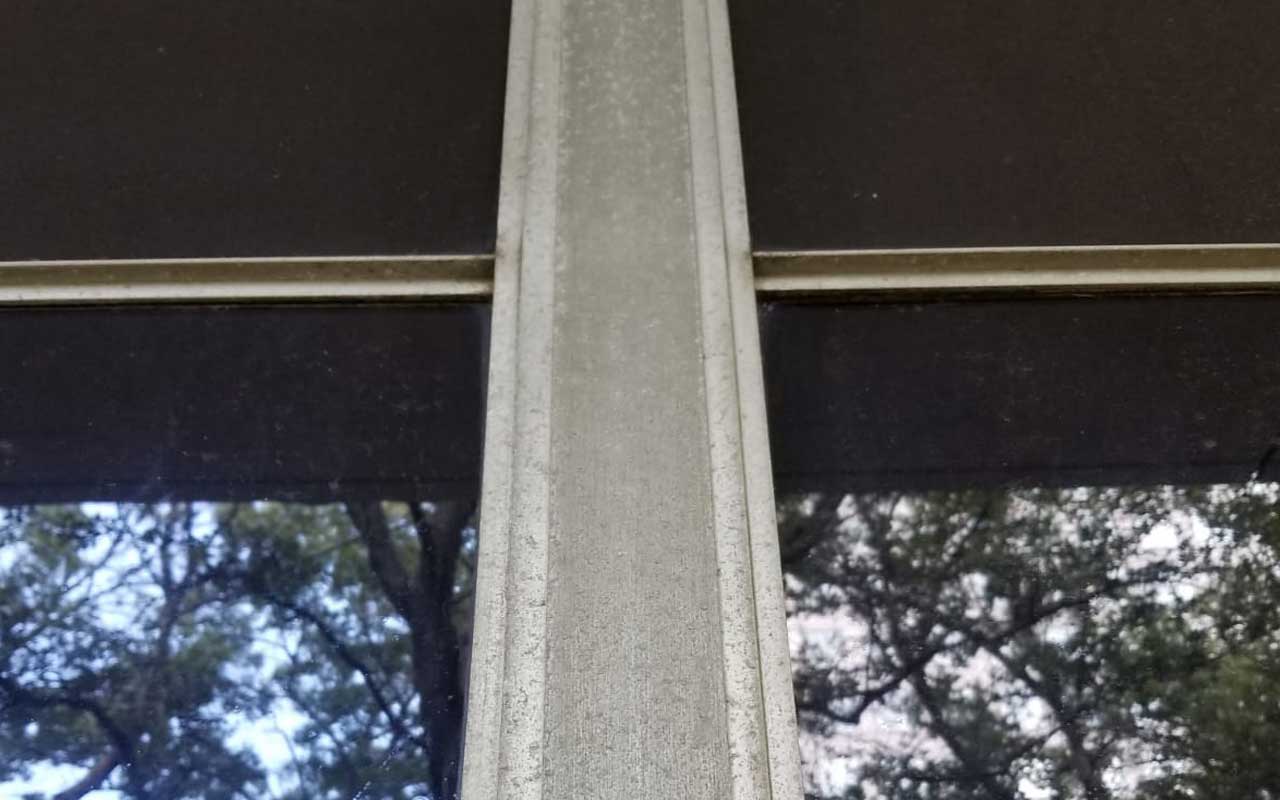Anodized aluminum window frame restoration services can remove stains, corrosion, pitting, and oxidization leaving the windows on your commercial building often looking good as new. Whether they were damaged by salt air or water, chlorine, acid, lime residue, chemicals, and solvents, the results are impressive, and the much more cost effective than replacing the window frames.
Questions About Anodized Aluminum Window Frames
When we talk with commercial building owners and managers they tend to have a lot of questions about anodized aluminum window frame restoration.
- Why are my anodized aluminum window frames stained?
- Should I paint the window frames?
- Can you restore my building’s anodized aluminum window frames to their original condition?
We generally recommend restoration of anodized aluminum window frames over painting them. There’s a simple reason for this: the factory-applied anodization is an extremely hard, durable, and long-lasting finish applied to the aluminum frame. In most cases, even without regular, typical maintenance, the finish will last for many years without showing signs of wear or staining.
Sometimes though, the anodized coating may be pitted, or abraded through. In those cases, painting is the only viable option. Since most common paints do not last as long as an anodized coating, they will require more frequent maintenance in order to achieve the same visible results as a factory anodized coating. Unfortunately, there are times anodized window frame restoration is simply not an option.
What Damages the Finish of my Anodized Aluminum Window Frame?
The two most common factors behind staining on anodized aluminum window frames in the commercial environment are:
Additive type staining where some type of addition applied to the surface of the anodization has resulted in a poor appearance that calls for anodized aluminum window frame restoration.
A good example of additive type staining we often see in the field is soap scum stains on anodized aluminum window frames in the curtain wall system. As the windows are cleaned a couple times per year, the soapy window cleaning residue is squeegeed down off the windows and then sits on the frame surface. When it rains, this mixture runs down onto the face of the frames and dries in the sun. As the process is repeated over the year, soap scum stains build up.
Another common additive type stain we see on anodized aluminum window frames is hard water stains. Hard water stains are similar to soap scum stains in that minerals repeatedly run out of the stone surfaces located above the frames when it rains and then dry in the sun and adhere to the surface of the frame.
Other types of additive type stains which trigger the need for anodized aluminum window frame restoration include, but aren’t limited to, rust leaching from window lintels, deteriorated coatings, and sprinkler system overspray.
The second type of staining which occurs on commercial buildings is related to the degrading of the anodized finish itself. This typically occurs as a result of UV degradation to the anodized surface of the frame. While other chemicals or processes may occasionally cause this type of staining, the vast majority of the time it’s the result of sun exposure.
This type of staining is particularly evident in darker colored aluminum window frames. Its chalky appearance cannot be removed with the same type of abrasive treatments that remove additive type stains. Rather, because this type of stain eats into the anodized coating, it requires the removal of the top surface of the anodization in order to remove the staining. Since anodized coatings are only a few millimeters thick, it’s best to apply a “hiding clear coat” to the frames after proper preparation.
Our Anodized Aluminum Window Frame Restoration Process
In general, when performing anodized aluminum window frame restoration, Presto uses clear coats to help protect the restoration investment. Property owners and managers often seek out an enhancing clear coat to make the window frame “pop” on the building. In reality, though, new window frames typically contain a matte finish and most types of enhancing treatments are short lived or will require regular maintenance. Instead, we typically recommend an invisible silicone for a protective treatment. To prevent future staining, this silicone treatment is applied after the restoration process. There are times when management desires an option to help enhance the building’s appearance or to hide deep damage. In those cases, we apply a semi-gloss coating to the surface; this coating generally lasts five to 10 years.
No matter what type or extent of damage your building’s anodized aluminum window frames may have, restoring them is a smart investment. Though it’s true stained window frames don’t always have the same precedence as say fixing a broken A/C handler or leaking windows, they certainly present poor curb appeal.
Why not request an analysis of your building’s damaged anodized aluminum window frames today? Our commercial anodized aluminum window frame restoration technicians have miles of experience making this material look new again. They’re skilled at applying protective treatments that allow for easy maintenance of the surface moving forward. If the window frames are regularly cleaned and protective treatments applied at the end of their service life, future anodized aluminum window frame restoration can be avoided entirely.
You can read about a recently completed commercial building window restoration project and many other projects on our portfolio page.
If you are looking to restore the finish of your commercial building’s windows, we would love to learn more about your project.
Contact Presto Restoration for a free consultation today.
Call us at 1-800-785-9927 or Request A Quote.





